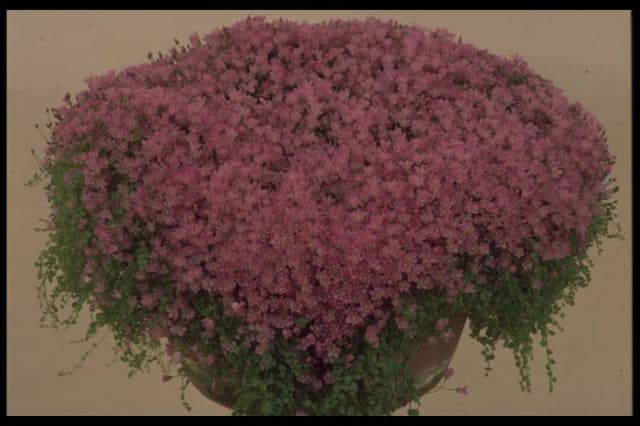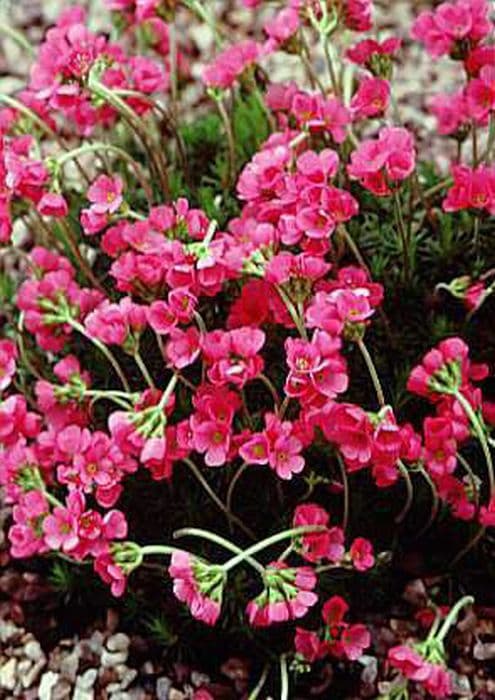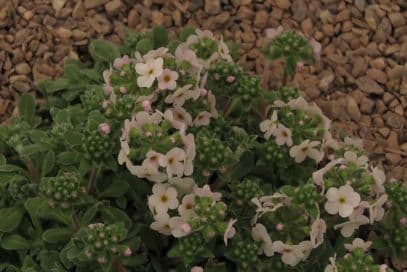Himalayan Cowslip Primula sikkimensis (Si)
ABOUT
Primula sikkimensis, commonly known as Sikkim cowslip, is a flowering plant with a distinctive look. It bears lush, green leaves at its base that emanate in a rosette pattern. The leaves are typically large, tongue-shaped, and have a slightly ruffled texture with smooth margins. The foliage provides a soft, verdant backdrop for the striking blooms it produces. The flowers of the Sikkim cowslip are especially captivating; they present themselves in a cluster at the top of a tall stem, forming a kind of umbrella-like arrangement. Each individual blossom is bell-shaped with a golden-yellow hue that exudes a sense of warmth and cheerfulness. The petals are delicate and may show a hint of a lighter color around the edges, contributing to the plant's overall gentle and inviting appearance. With their drooping heads, the flowers give off an elegant and graceful look, resembling lanterns. The blooms come together in a tiered fashion, adding to the visual interest and ornate quality of the floral display. During its blooming period, the Sikkim cowslip turns into a focal point of beauty, potentially attracting pollinators like bees and butterflies who are drawn to its vibrant color and possibly its nectar. Overall, the Sikkim cowslip is a plant that exudes a lush and robust presence in a garden setting, offering a pop of color with its sunny blossoms that contrast beautifully against its rich green leaves.
About this plant
 Names
NamesFamily
Primulaceae
Synonyms
Himalayan Primrose, Sikkim Cowslip, Sikkim Primula
Common names
Primula sikkimensis Hook.
 Toxicity
ToxicityTo humans
The Himalayan cowslip (Primula sikkimensis) is not widely known to be toxic to humans. However, as with many plants, it is advisable to avoid ingestion since individual sensitivity to plant compounds can vary, and there is limited specific information on this species' effects if ingested.
To pets
The Himalayan cowslip (Primula sikkimensis) is not specifically listed as toxic to pets. However, gastrointestinal upset is a common response in pets to the ingestion of non-food plants, and individual animals may have specific sensitivities. It is generally recommended to prevent pets from ingesting plants not known to be safe.
 Characteristics
CharacteristicsLife cycle
Perennials
Foliage type
Deciduous
Color of leaves
Green
Flower color
Yellow
Height
1-2 feet (30-60 cm)
Spread
1 foot (30 cm)
Plant type
Herb
Hardiness zones
7
Native area
Himalayas
Benefits
 General Benefits
General Benefits- Ornamental Value: Primula sikkimensis, commonly known as Himalayan cowslip, is valued for its ornamental appeal due to its bright yellow flowers that can enhance the visual aesthetics of gardens and landscapes.
- Pollinator Attraction: The flowers of the Himalayan cowslip attract various pollinators such as bees, butterflies, and other beneficial insects, supporting local ecosystems and biodiversity.
- Easy Cultivation: This plant is known for being relatively easy to cultivate in moist, well-drained soil, making it accessible to gardeners of various skill levels.
- Cultural Significance: In some cultures, the Himalayan cowslip may have symbolic importance or be used in traditional gardening practices, contributing to cultural heritage.
- Seasonal Interest: The plant adds seasonal interest to gardens, especially during its blooming period in spring, creating a dynamic and changing landscape.
 Medical Properties
Medical PropertiesThis plant is not used for medical purposes.
 Air-purifying Qualities
Air-purifying QualitiesThis plant is not specifically known for air purifying qualities.
 Other Uses
Other Uses- Primula sikkimensis, commonly known as Himalayan Cowslip, can be used as a natural dye, producing a range of colors when used with different mordants (chemicals that fix dyes to fabrics).
- The flowers of Himalayan Cowslip may be candied and used as edible decorations on cakes and pastries, offering a sweet, floral note to desserts.
- Himalayan Cowslip is often planted to attract pollinators like bees and butterflies to gardens, supporting local biodiversity.
- The leaves of Primula sikkimensis can be used as a mulch that will decompose, enriching the soil with organic matter and nutrients.
- The plant has been used as part of living roof systems where its hardiness and low-maintenance requirements contribute to sustainable roofing methods.
- Because of its robust nature, the Himalayan Cowslip can be used for erosion control on slopes or areas prone to soil degradation.
- Himalayan Cowslip's vibrant flowers can be utilized in nature photography, botanic illustration, and art projects as a natural subject of beauty.
- During plant breeding, it might serve as genetic stock to introduce hardiness or specific aesthetic traits to new plant cultivars.
- In some cultures, the flowers may be used in traditional clothing or garlands for festivals and ceremonies for their visual appeal.
- Himalayan Cowslip can be planted in memorial or botanic gardens for its symbolic meanings in different cultures, such as vitality and the arrival of spring.
Interesting Facts
 Feng Shui
Feng ShuiThe Himalayan cowslip is not used in Feng Shui practice.
 Plant Symbolism
Plant Symbolism- Hope: In the language of flowers, the Primula is often associated with hope due to their early bloom, signaling the end of winter and the arrival of spring.
- Youth: The delicate and fresh appearance of the Himalayan Cowslip blooms are symbolic of youth and young love.
- New Beginnings: Their emergence in early spring ties them to the theme of new beginnings or starting anew.
- Perseverance: As a plant that emerges after the thaw of harsh conditions, the Himalayan Cowslip epitomizes perseverance and the ability to overcome challenges.
 Water
WaterFor Himalayan Primrose, which is the common name for Primula sikkimensis, it's important to maintain consistently moist soil, without letting it become waterlogged. Water the plant thoroughly when the top inch of the soil feels dry to the touch, which could be about once or twice a week depending on the environment. As a rough estimate, this may equate to approximately 16 ounces of water each time for a small to medium-sized pot. Adjust the frequency of watering based on the season, with less frequent watering in the winter months when the plant is not actively growing.
 Light
LightHimalayan Primrose thrives best in bright, indirect light. It should be placed in a spot that is shielded from the harsh afternoon sun, which can scorch its leaves. An ideal spot would be near a north-facing window or a location with filtered sunlight, ensuring the plant receives enough light without the damaging effects of direct sun exposure.
 Temperature
TemperatureHimalayan Primrose prefers cooler temperature conditions, ideally between 50 to 70 degrees Fahrenheit. The plant can tolerate temperatures down to about 40 degrees Fahrenheit but should be protected from frost. Avoid placing it in locations with drastic temperature changes or near heat sources that could cause stress to the plant.
 Pruning
PruningPrune Himalayan Primrose to remove dead or yellowing leaves and spent flower stems to encourage new growth and improve air circulation. This should be done as needed throughout the growing season. The best time for pruning is immediately after flowering when you can also divide the plant if necessary to maintain its size and vigor.
 Cleaning
CleaningAs needed
 Soil
SoilHimalayan Primrose prefers a well-draining, humus-rich soil with a pH of 6.0 to 7.5. A mix of peat, perlite, and organic compost works well to maintain moisture while providing adequate drainage.
 Repotting
RepottingHimalayan Primrose should be repotted every 1-2 years or when it outgrows its current pot ensuring fresh soil and room for growth.
 Humidity & Misting
Humidity & MistingHimalayan Primrose thrives in moderate to high humidity levels, generally between 50% - 70%.
 Suitable locations
Suitable locationsIndoor
Ensure bright, indirect light and high humidity.
Outdoor
Plant in part shade, moist, well-drained soil.
Hardiness zone
5-8 USDA
 Life cycle
Life cycleThe Sikkim cowslip (Primula sikkimensis) begins its life as a seed, which, when sown in a moist and cool environment, germinates to produce a small seedling. The seedling grows into a rosette of leaves close to the ground, a vegetative stage in which it can endure for one or more seasons. With sufficient light, moisture, and nutrients, the plant will then develop a flower stalk, which culminates in a cluster of yellow, fragrant flowers, usually in late spring or early summer. After pollination, which often involves insects, the flowers develop into capsules containing numerous tiny seeds. As the season progresses, the plant enters a period of dormancy, especially in colder climates, where it conserves energy and resources by dying back to the ground. The following spring, the plant may either sprout anew from leftover roots or seeds in the soil, thereby continuing its perennial life cycle.
 Propogation
PropogationPropogation time
Spring-Early Summer
Himalayan Primrose, scientifically known as Primula sikkimensis, is often propagated through seeds as the most popular method. To successfully propagate by seed, one should sow the seeds in a cold frame as soon as they are ripe in late summer. The cold frame mimics the natural alpine conditions, providing cool and moist circumstances which encourage germination. It’s important to only lightly cover the seeds with soil as they require some light to germinate effectively. Once seedlings are large enough to handle, they can be transplanted into individual pots and grown on in cooler conditions until they are ready to be planted into their permanent positions. Seedlings usually take 2 to 3 years to flower after sowing.









